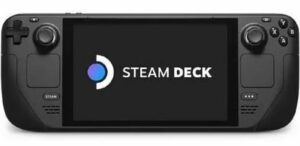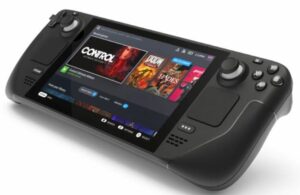The Steam Deck has emerged as a powerhouse in the realm of handheld gaming consoles, offering not only impressive power but also becoming a playground for tech enthusiasts. In comparison to its portable gaming counterpart, the Nintendo Switch, the Steam Deck has carved a niche for itself, even introducing users to the world of Linux.
Fundamentally, the Steam Deck functions as a gaming PC, serving as a robust device that puts your entire Steam library at your fingertips, enabling you to enjoy PC games on the go. If you’re considering foraying into the world of Steam Deck gaming this year, the decision on which variant to select may be a perplexing one, especially because of the availability of various versions and storage options. With three storage options available, each catering to different needs, let’s break down the choices and make it easier for you to determine the best fit for your needs:
Comparing Steam Deck Variants and What Distinguishes Them
Valve Corporation offers three base models of the Steam Deck, along with two OLED variants. While each console has exactly the same specifications, the key distinctions in their hardware come from the screen and the amount and type of storage they come with. Each storage variant comes with a different price tag and the top-tier model featuring an anti-glare screen increases its price even more. Here are the major differences along with a comparison sheet to make it easier for you to choose what fits your needs.
1. Steam Deck 64GB eMMC:
The entry-level model is a budget-friendly option, ideal for tech enthusiasts who relish the prospect of tinkering with their devices. While the 64GB model may lack the NVMe SSD found in the other variants, it provides solid value for those who enjoy hands-on upgrades. A comprehensive guides are available for users looking to expand their storage through various means, including MicroSD cards.
2. 256GB NVMe SSD:
Positioned as a middle ground, the 256GB model strikes a balance between capacity and affordability. If you prefer to avoid technical upgrades and desire ample storage right from the start without a significant investment, this variant may be the sweet spot for your gaming needs.
3. 512GB NVMe SSD:
The top-tier option offers the maximum storage capacity, accompanied by an anti-glare screen for an enhanced visual experience. Beyond these features, the core specifications of all three versions remain consistent. The 512GB variant also includes an exclusive colored carry case, setting it apart aesthetically from the non-colored 256GB and 64GB models.
Distinguishing Features:
- The 64GB model uses eMMC storage, while the 256GB and 512GB models feature NVMe drives.
- The 512GB version comes with an anti-glare screen and an exclusive colored carry case.
Detailed Comparison Sheet:
| Comparison Criteria | Steam Deck 64GB | Steam Deck 256GB | Steam Deck 512GB | Steam Deck OLED |
| Price | $399 | $529 | $649 | $999.99 |
| Chipset | AMD Aerith APU | AMD Aerith APU | AMD Aerith APU | AMD Aerith APU |
| CPU | Zen 2 Architecture, 4 core 8 threads 2.4-3.5 GHz | Zen 2 Architecture, 4 core 8 threads 2.4-3.5 GHz | Zen 2 Architecture, 4 core 8 threads 2.4-3.5 GHz | Zen 2 Architecture, 4 core 8 threads 2.4-3.5 GHz |
| GPU | RDNA 21.0 – 1.6 GHz 1.6 TFlops FP32 | RDNA 21.0 – 1.6 GHz 1.6 TFlops FP32 | RDNA 21.0 – 1.6 GHz 1.6 TFlops FP32 | RDNA 21.0 – 1.6 GHz 1.6 TFlops FP32 |
| RAM | 16GB LPDDR5 | 16GB LPDDR5 | 16GB LPDDR5 | 16GB LPDDR5 |
| Storage | 64GB eMMC + expandable microSD storage | 256GB NVMe SSD + expandable microSD storage | 512GB NVMe SSD + expandable microSD storage | 512GB or 1TB NVMe SSD + expandable microSD storage |
| Display | 1280 x 800, 60Hz 7 inches IPS LCD touchscreen | 1280 x 800, 60Hz 7 inches IPS LCD touchscreen | 1280 x 800, 60Hz 7 inches IPS LCD touchscreen Anti-glare coating | 1280 x 800 HDR OLED display. Etched glass on 1TB model |
| Battery | 40Whr 2-8 hours of gameplay | 40Whr 2-8 hours of gameplay | 40Whr 2-8 hours of gameplay | 50Whr battery; 3-12 hours of gameplay |
| Weight & Dimensions | 298mm x 117mm x 49mm 660 grams | 298mm x 117mm x 49mm 660 grams | 298mm x 117mm x 49mm 660 grams | 298mm x 117mm x 49mm 630 grams |
| Extras | Carrying case | – Carrying case – Exclusive Steam Community profile bundle | – Anti-glare etched glass screen – Exclusive carrying case – Exclusive Steam Community profile bundle – Exclusive virtual keyboard theme | Same as Steam Deck 512 + WiFi 6E |
What’s New in the Steam Deck OLED Model?
While the OLED model doesn’t introduce upgrades to performance components; rather, it primarily focuses on improvements in the screen and battery life, accompanied by a few additional features. The screen itself undergoes a significant enhancement, offering more vibrant colors, deeper blacks, higher refresh rates, and a slightly larger display – all thanks to the OLED technology. If you’re accustomed to the quality of an OLED TV or monitor, opting for the OLED Steam Deck becomes an obvious choice and there’s no going back.
A notable improvement comes in the form of enhanced battery life on the OLED Steam Deck, boasting up to 25% better performance compared to the LCD version. This improvement is attributed to the OLED’s lower power consumption, and its slender profile allowed Valve to incorporate a larger 50 WHr battery, replacing the previous 40 WHr.
Moreover, the OLED Deck comes with a couple of appealing extras. It features Wifi 6E, facilitating faster downloads, and introduces the convenience of wake-on-Bluetooth functionality for users who prefer playing in docked mode with a controller, eliminating the need to manually power on the device.
Do You Really Need More Storage?
The primary distinction among the three Steam Deck models lies in their storage capacities. It’s important to note that all Steam Deck variants support expandable storage through microSD or USB 3.0 devices, although games typically run most efficiently from internal storage.
Firstly, the models vary in capacity: 64GB, 256GB, and 512GB. Your choice depends on the genres of games you play and the number you wish to have simultaneously installed. Games like visual novels, puzzles, and platformers generally require less storage. However, if you enjoy AAA titles, which often demand substantial space (e.g., Red Dead Redemption 2 requiring 150GB), the internal storage of the base 64GB model may fall short.
Consider the number of games you want readily available on your Steam Deck at any given time. While you can download and uninstall as needed, being without internet may pose a challenge. If you prefer having numerous games at your fingertips, the 64GB option may not suffice.
Secondly, the models employ different storage technologies. The 64GB model utilizes eMMC, while the 256GB and 512GB models employ NVMe SSD, a faster technology. According to Valve, the 64GB eMMC loads games 12.5% slower than the 512GB NVMe SSD, with 25% slower boot speed. Additionally, due to the scaling of NVMe, the 512GB model outpaces the 256GB model.
Although internal storage is replaceable, it involves a delicate procedure best suited for the tech-savvy. Therefore, choose wisely based on your gaming preferences. If you indulge in storage-intensive games and want the ability to have as many installed as possible, the 512GB Deck would be a better choice. Otherwise, for most users, the 256GB model should prove more than sufficient.
Conclusion
Selecting the appropriate Steam Deck model revolves around understanding your gaming habits and preferences. The crucial factor distinguishing these variants is their storage capacities, with considerations ranging from the types of games you enjoy to the number you wish to have readily available. The differences in storage technologies, particularly the use of eMMC in the 64GB model and NVMe SSD in the 256GB and 512GB models, contribute to varying loading speeds. For those who prioritize seamless gameplay and faster boot times, the advantages of NVMe technology, especially in the 512GB model, become apparent.
Ultimately, the decision between models extends beyond mere technical specifications. It involves a careful evaluation of your gaming preferences, the genres you favor, and the desire for simultaneous game access.
Also Read:
How to Mount ISO files on the Steam Deck?
How to fix the Steam Deck cloud sync error?





